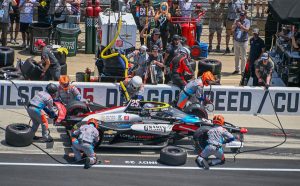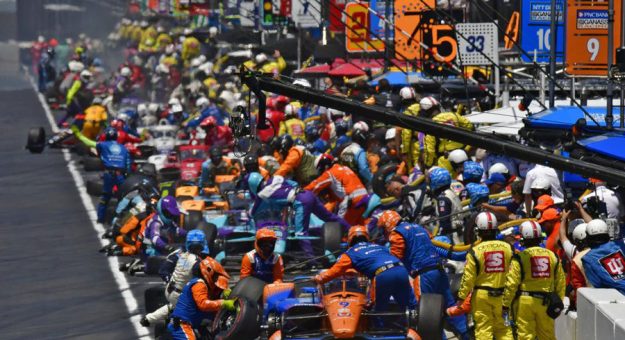When this year’s Indianapolis 500 field was stuck at 32 entries in April, there remained plenty of interest from team owners and drivers wanting to participate in the famed race.
The issue was a lack of qualified racing mechanics, pit crew members and other key personnel to help field those entries.
The labor shortage that has affected the United States economy has found its way to auto racing. It’s not just the NTT IndyCar Series feeling the impact, it’s also NASCAR and IMSA sports car teams that are having issues finding experienced, trained crew members and mechanics.
It wasn’t long ago that there were more racing mechanics than there were jobs. But once the COVID-19 pandemic struck and sidelined much of the nation’s workforce, they used that time to re-evaluate their lives and careers.
“When I got into the sport 40 years ago, you had to pay your dues to get to IndyCar because you could go road racing or Trans-Am racing or any of the lower-tier series,” Mitch Davis, general manager of Wayne Taylor Racing’s IMSA operation, told SPEED SPORT. “To get to IndyCar, you really had to know somebody that had gotten there and put in a good word for you.
“Over the years, the pay scale hasn’t evolved. You can drive a truck for Wal-mart and make $100,000 a year. You can go to FedEx and make as good a money as being an IndyCar mechanic. And the tech schools aren’t training mechanics anymore. People are going to tech schools and learning about computers and not working on cars.”

Davis says his team has had to go to grassroots racing to find mechanics and train them to work on sports cars.
“There is a small group of kids that like smaller cars and that is why road racing is coming back,” Davis continued. “IndyCar road racing is so good with the engine technology and electronics and the hybrid technology that is coming might attract more of the younger generation back to racing.”
Davis believes it’s a key to train his mechanics from the ground up because the pay scale in the U.S. economy is out of balance.
“The sponsorship isn’t in motor racing like it used to be,” Davis said. “Cigarette companies are gone; beer companies are gone. Now, it’s tech companies and it’s all business-to-business relationships and they run race teams now like corporations.
“It’s about not spending the team owner’s money.”
This year’s weekly IndyCar grid is between 26-28 cars. Many of the teams that used to expand by an extra car for the Indianapolis 500 have done that for the full season.
Expanding the full-time lineup took away many qualified mechanics from the Indy 500 one-off entries.
Stefan Wilson discovered that when he became the 33rd and final entry for the 106th Indianapolis 500.
His car was a partnership with Don Cusick. Elton Julian’s DragonSpeed LMP2 sports car team members served as the crew and the car was provided by A.J. Foyt Racing.
Because the current IndyCar field is so strong and so deep, the Indy 500 has become a victim of IndyCar’s growth.
“I think you’re spot on,” Julian told SPEED SPORT. “It’s almost like a victim of its own success in a way, but it only hurts at the speedway. If you think about it, you if you go through the list of teams in your head that were an option to also join the grid, the fact that DragonSpeed is one of the only ones on that list, everybody else is already in the field.
“There are not many other teams that can come and do one-offs like they used to in the past. It’s going to be a tough one to navigate moving forward, I’m sure, for the Indianapolis Motor Speedway, because as they galvanize these quality entries, full-budget, top drivers really focused at the 26 to 28 number, it’s going to be difficult.
“There is going to have to be definite movement to make the possibility happen, to have available engines, to have available chassis and also to have some level of commitment from the biggest teams that they have to do it, or I don’t see how else you can. We’ll join; hopefully, that will take care of 29.”
Wilson encountered the crew shortage when piecing together his Indy effort
“I think as well as someone else pointed out to me two or three months ago, it’s not just the general interest in IndyCar, but in motor racing across the country right now,” Wilson said. “You’re seeing record-sized fields in Ferrari Challenge and Porsche Carrera Cup, even Super Trofeo, even in the Road to Indy. We have got grid sizes that are huge.
“Each one of those cars in all of these different series is utilizing personnel and it’s just making it harder to find the right personnel to do these one-off entries because they’re already committed for the year, or they have a conflict on their schedule.”
Julian believes the causation of this dilemma began 10-20 years ago.
Schools stopped teaching vocational skills and shifted class emphasis toward liberal arts. There remain plenty of racing engineers in the marketplace, but fewer actual skilled mechanics.
“I think we’ve suffered a little bit from getting new blood in,” Julian said. “Racing sports cars and racing around the world, I will say that the average age of the crew member in IndyCar is way older than anywhere else I see, and the first time we went to IndyCar with my European crew, they were like, ‘Wow, we’re really young here.’ So, I think there’s been a lack of new blood.
“Some of the older, talented guys that are in retirement mode now, that have left, you’ve got to beg the Andy Browns and these guys to come back out and do a race with you. So, there’s been very little backfill from that, and you have a lot of kids now that go to school that have engineering degrees that want to get paid like 150 coming out of school. Nobody wants to just go work, so I think that’s part of it.”
Another factor is the growing number of IMSA teams that have taken quality crew members and mechanics away from IndyCar, according to Arrow McLaren SP’s Craig Hampson, the team’s director of trackside engineering.
“Penske’s Porsche team has vacuumed up a lot of people who would otherwise be in the IndyCar paddock,” Hampson said. “It’s a shortage of skilled folks who have reached a high enough skill level through their Indy Lights or F2000 racing where they are capable to be trusted to wrench on an Indy car, and that they want to wrench on an Indy car.
“If you look at the Indy Lights paddock, that’s a retirement plan. Some of the mechanics don’t want the IndyCar grind anymore, so they prefer working on a Lights team or F2000 team. We need some new blood, particularly new blood on the mechanics side to staff the cars. That, to me, is the biggest thing.
“If you talk to team managers, No. 1 shortage is truck drivers. It’s impossible to get truck drivers. No. 2 is mechanics. There are a lot of young, smart engineers applying for jobs.
“Truck drivers are the worst job on the team. I wouldn’t want to be a truck driver. You work so hard and then you get in the truck and drive one or two days. You are away more than anyone on the team. It’s not like you drive it there and then you hang out, some of the truck drivers are pit crew members or tire guys or take care of setting up the pit boxes. It’s a hard job.
“For the same amount of money, you can drop off FedEx packages. You have to love racing because if you choose to do this over some truck driver job, you are doing it because you love racing.”
Larry Foyt is president of A.J. Foyt Racing. This year, he has three full-time entries in IndyCar with four drivers.
Those include Kyle Kirkwood and Dalton Kellett in all races with Tatiana Calderon on the street and road courses and J.R. Hildebrand on the ovals.
In the past, Foyt’s team has expanded to four entries at the Indianapolis 500. This year, he didn’t have the crew members, so he made an extra car available to Wilson’s effort.
“Our deal came together pretty late, so that made it an extra challenge,” Foyt told SPEED SPORT. “We’ve had some great young guys and some great résumés, but it’s hard to find guys with IndyCar experience. We were lucky to find a couple to help train these guys, but we have a lot of young guys.
“In the short term, having more full-time cars, guys have added a lot of people. Over the past 13-14 years, I see more engineering résumés coming to me instead of mechanics. There are a lot of young people that are interested in motorsports, but it’s hard to bring them straight to IndyCar. It would be nice to bring them up through the ranks.”
